FINA Committee Report
If you have any questions or comments regarding the accessibility of this publication, please contact us at accessible@parl.gc.ca.
Supported by relatively strong consumer spending and business investment, Canada’s real Gross Domestic Product (GDP) grew by 3.1% and 2.8% in 2005 and 2006 respectively. According to the October 2007 Department of Finance survey of private-sector forecasters, real GDP is expected to grow by 2.5% in 2007, by 2.4% in 2008 and by 2.7% in 2009, as shown in Figure 1.1. On an annualized basis, growth in real GDP was 3.6% in each of the first and second quarters of 2007, and was 2.8% in the third quarter.
Figure 1.1 — Growth in Real Gross Domestic Product (GDP), Canada, 2005 - 2009
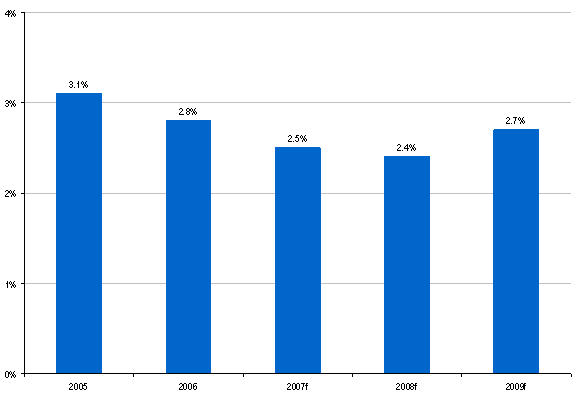
f = forecasts
Source: Statistics Canada
The Canadian economy has benefited from relatively strong commodity prices, especially in the energy sector. Between January and December 2007, the Bank of Canada Commodity Price Index increased in value by more than 20%, in large part as a result of higher energy prices. Crude oil prices (West Texas Intermediate) have been about US$90 per barrel since the beginning of November 2007, compared to about US$60 at the beginning of 2007.
The Canadian labour market continues to grow, with about 370,000 jobs created in 2007. Employment gains have contributed to the lowest unemployment rate in more than 30 years; in December 2007, the national unemployment rate was 5.9%. Job creation has, however, been uneven among the provinces, and the job market has been relatively stronger in the western provinces. Figure 1.2 shows provincial unemployment rates in December 2007.
Figure 1.2 — Unemployment Rate, by Province, December 2007
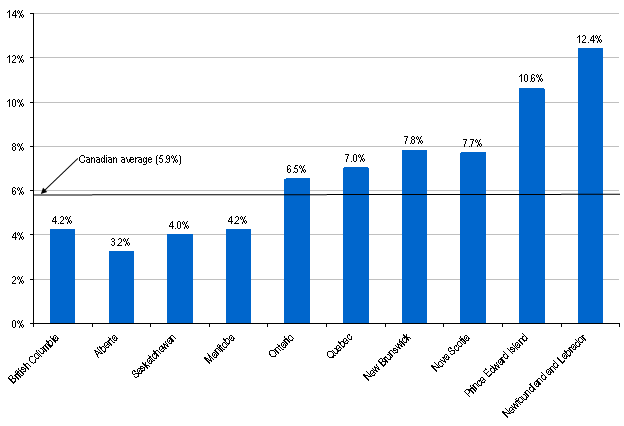
Source: Statistics Canada, Labour Force Survey
Canadian consumers have contributed to economic growth in recent years. The rate of growth in real consumer spending, at 3.8% and 4.2% in 2005 and 2006 respectively, has exceeded real economic growth. Consumer spending growth has been supported by such factors as a strong labour market and rising house prices. Concerns exist, however, about rising levels of personal debt and low rates of saving. As shown in Figure 1.3, the personal savings rate is relatively low from an historical perspective. Nevertheless, the net worth of Canadian households has continued to increase, notably because of rising house prices.
Figure 1.3 — Personal Savings Rate, Canada, 1990 - 2007

Source: Statistics Canada
Corporate profits are at near-record levels, as shown in Figure 1.4. Corporations have benefited from relatively high commodity prices, strong domestic demand and lower prices for imported inputs. These profits, coupled with the relatively lower cost of imported machinery and equipment resulting from the rising relative value of the Canadian dollar, have contributed to increased levels of business investment. From 2005 to 2006, the level of business fixed investment increased by 9.9%.
Figure 1.4 — Corporate Profits as a Percentage of Gross Domestic Product, by Quarter, Canada, 1990 - 2007
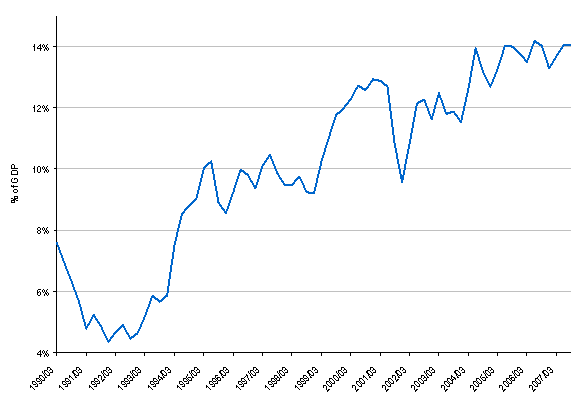
Source: Statistics Canada
From an historical and international perspective, the overall fiscal position of Canada’s federal government is sound. In 2006-2007, the government reported budgetary revenues of $236 billion and total expenses of $222.2 billion, resulting in a budgetary surplus of $13.8 billion, as shown in Figure 1.5. According to the October 2007 Economic Statement, surpluses are expected to continue through 2012-2013, even when planned federal debt reduction of $10 billion for 2007-2008 and of $3 billion for each of the years during the 2008-2009 to 2012-2013 period are considered.
Figure 1.5 — Federal Fiscal Outlook, Canada, 2006 - 2007 to 2012 - 2013 ($ billions)
2006–2007 |
2007–2008p |
2008–2009p |
2009–2010p |
2010–2011p |
2011–2012p |
2012–2013p |
|
Budgetary revenues |
236.0 |
243.9 |
245.8 |
255.4 |
266.7 |
277.8 |
288.9 |
Program expenses |
188.3 |
198.4 |
207.6 |
217.0 |
225.1 |
233.7 |
242.9 |
Public debt charges |
33.9 |
34.0 |
33.7 |
34.2 |
34.0 |
33.9 |
33.3 |
Total expenses |
222.2 |
232.3 |
241.4 |
251.1 |
259.2 |
267.6 |
276.2 |
Underlying surplus(1) |
13.8 |
11.6 |
4.4 |
4.3 |
7.5 |
10.2 |
12.8 |
Planned debt reduction |
10.0 |
3.0 |
3.0 |
3.0 |
3.0 |
3.0 |
|
Planning surplus |
1.6 |
1.4 |
1.3 |
4.5 |
7.2 |
9.8 |
|
Accumulated Deficit |
467.3 |
457.3 |
454.3 |
451.3 |
448.3 |
445.3 |
442.3 |
(1) Federal surplus before planed debt reduction
p: projections
Source: October 2007 Economic Statement
While federal budgetary revenues and program expenses are projected to increase in nominal terms until 2012-2013, they are expected to decline in relation to the size of the Canadian economy. Budgetary revenues as a share of Canadian GDP are expected to fall from 16.3% in 2006-2007 to 15.1% in 2012-2013, while program expenses as a share of GDP are expected to decrease from 13% in 2006-2007 to 12.7% in 2012-2013. Furthermore, the federal debt-to-GDP ratio is expected to fall from 32.3% in 2006-2007 to 23.1% in 2012-2013, its lowest level since the late 1970s.
MONETARY SITUATION AND INFLATION
The total Consumer Price Index (CPI) grew by 2.4% between December 2006 and December 2007, above the 2% midpoint of the Bank of Canada’s target range of 1% to 3%. Core CPI — total CPI minus the eight most volatile components as well as the effect of changes in indirect taxes — increased by 1.5% in that 12-month period; core CPI is the measure used by the Bank as its operational guide. Figure 1.6 presents the year-over-year percentage growth in total and core CPI during the January 1995 to December 2007 period.
Figure 1.6 — Growth in Total and Core Consumer Price Index (CPI), Canada, January 1995 - December 2007
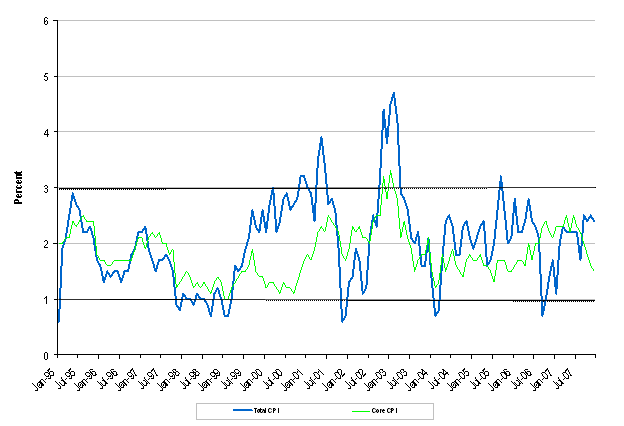
Source: Bank of Canada
On December 4, 2007 and again on January 22, 2008, the Bank of Canada reduced its target for the overnight rate by 25 basis points; at present, the rate is 4%. In announcing the most recent reduction, the Bank observed that the domestic economy continues to operate above its production capacity, and that there is likely to be additional downward pressure on export growth as a consequence of the effects of a weaker outlook for the U.S. economy. It also noted, however, that domestic demand is projected to remain strong despite tighter credit conditions.
THE RISE IN THE RELATIVE VALUE OF THE CANADIAN DOLLAR
The value of the Canadian dollar increased markedly in relation to the value of the U.S. dollar between April 2004 and January 2008, as shown in Figure 1.7. While a number of factors — including, for example, monetary and fiscal policy decisions, commodity prices, productivity and the level of foreign investment — can explain variations in the relative value of a currency, it is generally recognized that, among other factors, changes in the price of oil have had a significant impact on the relative value of the Canadian dollar, as Figure 1.7 and a number of empirical studies suggest. For example, a 2006 working paper published by the International Monetary Fund, entitled “Energy, the Exchange Rate, and the Economy: Macroeconomic Benefits of Canada’s Oil Sands Production,” found a positive correlation between Canadian oil exports and the relative value of the Canadian dollar.
Figure 1.7 — The Price of Oil and the Value of the Canadian Dollar Relative to the U.S. Dollar, April 1, 2004 - January 29, 2008
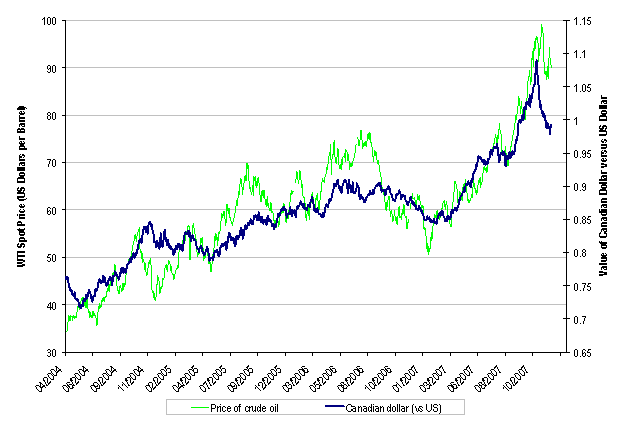
Note: The price of oil corresponds to the West Texas Intermediate spot price.
Source: Bank of Canada and Energy Information Administration
As noted earlier, in November 2007 the Committee announced that, during the 2007 pre-budget consultations, consideration would also be given to the impact of the appreciation in the relative value of the Canadian dollar. Some of our witnesses focussed exclusively on how the marked rise and volatility in the value of the Canadian dollar in relation to the U.S. dollar was affecting them, and made proposals for federal action.
In commenting on reasons for the appreciation in the relative value of the Canadian dollar, the Canadian Auto Workers Union told the Committee that the strength of the Canadian dollar, when compared to the performance of other currencies vis-à-vis the U.S. dollar, is the result of factors that are unique to the Canadian economy. Other witnesses, including the Fédération des chambres de commerce du Québec, Jarislowsky Fraser Limited and the C.D. Howe Institute, suggested that the relative value of the Canadian dollar is closely tied to natural resource prices, including oil.
Moreover, the TD Bank Financial Group and the C.D. Howe Institute said that the fiscal and current account deficits in the United States are putting downward pressure on the external value of the U.S. dollar vis-à-vis many other currencies. Because countries such as China and nations that belong to the Organization of the Petroleum Exporting Countries have quasi-fixed exchange rates in relation to the U.S., however, Canada’s currency has absorbed a disproportionate share of global adjustments, leading to a marked appreciation in the relative value of the Canadian dollar.
Some witnesses, including the Canadian Auto Workers Union, commented that the monetary policy of the Bank of Canada, through its influence on interest rates, is one of the main factors affecting the relative value of the Canadian dollar. According to it, the Bank of Canada’s recent actions regarding its target for the overnight rate were a mistake. The Canadian Labour Congress indicated that the movement in domestic interest rates is the only cause of the rise in the relative value of the dollar that can be influenced by Canada.
2. The General Effects of the Rise and Volatility
Witnesses, such as the Canadian Vehicle Manufacturers' Association, the Fédération des chambres de commerce du Québec and the Canadian Labour Congress, told the Committee that the rise in the relative value of the Canadian dollar is detrimental to the cost-competitiveness of Canada’s businesses, especially those in the manufacturing sector. The Canadian Manufacturers & Exporters indicated that, for many exporting companies, rapid appreciation in the relative value of the dollar has the same effect as a reduction in the prices of goods exported to the United States. According to it, for companies that are particularly affected by currency variations, a rapid rise in the dollar’s relative value may result in serious cash flow problems, which could escalate to credit problems and employee layoffs. Edson Packaging Machinery Limited suggested that the rise in the relative value of the Canadian dollar may lead to an industrial recession.
The Canadian Federation of Independent Business spoke to the Committee about the impact of the rising relative value of the Canadian dollar on small businesses. A survey conducted by it revealed that 27% of its members would prefer that the Canadian dollar have a relatively lower value, 21% would like it to have a relatively higher value and 52% did not see the relative value of the dollar as having a significant impact on their business.
The Canadian Council of Chief Executives noted that the rise in the relative value of the dollar has had some benefits, especially in terms of lower prices for imported goods, such as machinery and equipment from the United States. The Committee was also told that the rising relative value of the dollar may make purchases of research equipment from the United States less expensive than would otherwise be the case. It was argued that companies with financial difficulties because of the high relative value of the dollar may not be able to take advantage of the Scientific Research and Experimental Development (SR&ED) tax credit, however, since the credit is only refundable for small Canadian-controlled private corporations (CCPCs) on their first $2 million of qualified expenditures.
Witnesses, including the Association of International Automobile Manufacturers of Canada, the Centre for Spatial Economics and the Canadian Auto Workers Union, informed the Committee that it may take two to three years for the economic impacts of a relative appreciation in the exchange rate to materialize fully, especially in terms of employment effects.
3. The Effects on the Manufacturing Sector
Witnesses told the Committee that the Canadian manufacturing sector has lost more than 300,000 jobs since the relative value of the Canadian dollar started to rise in 2002. The Canadian Auto Workers Union predicted that, if the value of the Canadian dollar remains near parity with the U.S. dollar, there will be an additional 300,000 job losses in manufacturing in the next two to four years. The Centrale des syndicates démocratiques observed that people who lose their job may be unable to secure employment that is as stable as the job that was lost; as well, they may not have the skills that are needed to find employment in another field.
The Committee was also informed, however, that the rise in the relative value of the Canadian dollar is only one factor explaining the difficulties in the manufacturing sector. The University of Toronto’s Rotman School of Management commented that the manufacturing sector is becoming a relatively smaller part of the Canadian economy.
Some witnesses, including the Canadian Labour Congress and the Confédération des syndicats nationaux, indicated that corporate tax reductions are not very beneficial in helping financially vulnerable businesses adjust to the rise in the relative value of the Canadian dollar, since these businesses do not have sufficient profits to benefit from corporate tax changes. Nevertheless, the Canadian Manufacturers & Exporters advocated corporate tax reductions as a means of attracting investment. The University of Toronto’s Rotman School of Management suggested that Canada has one of the highest tax regimes with respect to new business investment, which is a disincentive to foreign investment.
For Cascades Inc., the volatility in the relative value of the Canadian dollar, rather than its appreciation, is the more damaging consideration. The Canadian Council of Chief Executives told the Committee that, over time, Canadian businesses can adjust to a rise in the relative value of the currency; however, these adjustments take time to be realized and are difficult when the currency’s relative value is highly volatile. The Forest Products Association of Canada argued that the volatility in the dollar’s relative value on foreign exchange markets is hindering the willingness of foreign entities to invest in Canada. The University of Toronto’s Rotman School of Management and the Centre for Spatial Economics indicated that the volatility makes it difficult to plan new investments.
Moreover, the Fédération des chambres de commerce du Québec and Professor Mario Seccareccia of the University of Ottawa informed the Committee about a phenomenon known as the “Dutch disease” or the “resource curse.” We were told that, following the discovery of natural gas in the North Sea, the relative value of the Dutch currency rapidly appreciated, with negative implications for the country’s manufacturing sector. Once the economic prosperity resulting from the discovery ended, the Dutch manufacturing sector was not viable.
4. The Effects on the Film and Television Sector
The Alliance of Canadian Cinema, Television and Radio Artists spoke to the Committee about the impact of the rising relative value of the domestic currency on the film and television sector in Canada. It indicated that more than one-half of the film and television production work in Canada involves U.S. companies filming here. The rise in the relative value of the dollar is increasing the cost of these foreign productions, resulting in fewer productions occurring here and fewer jobs for Canada’s film and television sector.
5. The Effects on the Tourism Sector
The Conference Board of Canada and the Tourism Industry Association of Canada commented on the impact of the rising relative value of the Canadian dollar on the domestic tourism sector. They said that the higher relative value of the Canadian currency makes it somewhat more difficult to attract foreign visitors, mostly Americans, and Canadians are relatively more likely to travel abroad than domestically. The Conference Board suggested that, with the appreciation in the relative value of the Canadian dollar since 2004, spending by Americans visiting Canada for non-business purposes will decline by about $1.9 billion per year between 2005 and 2008.
6. The Effects on Resource Sectors
The Forest Products Association of Canada and the Mayor of Hearst, Ontario informed the Committee about the difficulties in Canada’s forestry sector, in part arising from the rise in the relative value of the Canadian dollar. A number of towns in Canada, including Hearst, rely almost exclusively on the forestry sector to sustain their economy.
Moreover, Cascades Inc. noted that the prices and production costs of Canadian companies are no longer competitive. For example, it said that wages are 25-40% higher in Canada than in the United States; if the value of the Canadian dollar remains at parity with the U.S. dollar, it might have to move production to the United States. Cascades Inc. also commented on the lack of a carbon emissions trading mechanism in Canada, noting that it reduced its emissions by 10% in 2006 and is active in such a trading mechanism in Europe.
The Union des producteurs agricoles informed the Committee that the appreciation in the relative value of the Canadian dollar has had profound negative effects on Canada’s agricultural sector. It said that the reduced competitiveness of our farmers has resulted in a loss of market share and declines in prices, as well as in increases in imports and decreases in exports of agricultural products.
7. The Effects on Retailers and Consumers
Witnesses told the Committee that the rising relative value of the Canadian dollar is affecting consumer expectations about the prices of products sold in Canada and in the United States. Option consommateurs shared its view that there are no logical explanations for price differences between products sold in Canada and in the United States. In commenting on automobile prices in particular, however, Toyota Canada Inc. indicated that variations in prices among similar cars sold in Canada and in the United States reflect, to a large extent, differences in standard equipment, regulations, taxes and other fees.
The Retail Council of Canada informed the Committee that retailers often purchase goods up to one year before they are sold; consequently, retailers have not benefited from the rise in the relative value of the Canadian dollar. It also suggested that excise taxes on a number of imported goods are much higher in Canada than in the United States, which is reflected in the prices charged by retailers. Finally, we were told that most retailers purchase their goods from Canadian manufacturers and distributors; these goods are priced in Canadian dollars.
Key Porter Books noted that the development of a book begins, on average, 18 months before the book is ready to be sold in retail stores; all costs associated with the publishing of books that are currently available were incurred before the most recent appreciation in the relative value of the Canadian dollar. It also indicated that some costs faced by Canadian publishers are denominated in Canadian dollars; consequently, a rise in the relative value of the dollar does not always result in cost savings for them. Key Porter Books also commented on the public perception that the recent rise in the relative value of the Canadian dollar should immediately result in lower prices for books, and said that public pressure for lower prices is challenging the profitability of Canadian publishers.
8. The Bank of Canada and Exchange Rates
A number of witnesses mentioned the role of the Bank of Canada in the context of the rising relative value of the Canadian dollar. Professor Seccareccia suggested that the Bank of Canada could intervene on foreign exchange markets in order to reduce volatility, especially when it is driven by speculation, while the Forest Products Association of Canada supported such intervention in order to signal that excessive levels of exchange rate volatility and speculation in respect of the external value of the Canadian dollar will not be tolerated.
The Fédération des travailleurs et travailleuses du Québec said that the Bank of Canada’s mandate should not be restricted to controlling inflation; the mandate should also include consideration of the exchange rate and economic stability. It argued that the problems caused by the appreciation in the relative value of the domestic currency exceed those that could result from relatively higher inflation.
Other witnesses, such as the C.D. Howe Institute, suggested that the Bank of Canada should continue its policy of not taking action in order to influence movements in the relative value of the Canadian dollar, other than in extraordinary circumstances. The Committee was also told that the federal government should not give directions to the Bank of Canada in the conduct of its monetary policy. Such witnesses as the Canadian Federation of Independent Business and the Centre for Spatial Economics supported the independence of the Bank of Canada in this regard.
Some witnesses, including the Canadian Manufacturers & Exporters, argued against the creation of a monetary union between Canada and the United States, and Professor Seccareccia shared his view that a monetary union with the United States would remove the ability of the Bank of Canada and Canadian governments to pursue macroeconomic stabilization policies or long-term economic growth strategies. The Committee was also told that the recent volatility in the relative value of the Canadian dollar is unusual, and that the Canadian economy is well-served by a currency that can adjust to Canadian economic circumstances. The C.D. Howe Institute supported a floating exchange rate, indicating that such an approach has been working relatively well for the domestic economy.
Other witnesses, such as the University of Toronto’s Rotman School of Management, supported the adoption of a policy — perhaps a fixed exchange rate or a monetary union with the United States — that would result in reduced exchange-rate volatility. Jarislowsky Fraser Limited suggested that Canada should adopt a fixed or pegged exchange rate with the United States, a measure that would protect about 85% of Canada’s exports from currency fluctuations.
9. Proposals for Federal Action
Witnesses proposed a variety of federal actions that could be taken to help mitigate the effects of the rise in the relative value of the Canadian dollar. Proposals related to taxes, fees and other charges included:
· in respect of corporate taxes,
· extending, for an additional five years if not permanently, the 50% straight-line accelerated capital cost allowance rate for manufacturing and processing investments;
· developing investment tax credits and/or other incentives for the manufacturing sector;
· making the Scientific Research and Experimental Development tax credit refundable for all claimants and broadening eligible expenses under the program to include the cost of obtaining a patent and of training employees;
· providing and/or enhancing tax incentives for productivity-improving business investments;
· ensuring that the Canadian corporate tax system is competitive, especially with respect to the effective tax rate on capital investment;
· eliminating duties on imported products when the duties are relatively higher in Canada;
· introducing tax incentives for the creation of new jobs;
· targeting tax relief to businesses in regions with an economy primarily based on such sectors as natural resources or manufacturing;
· in respect of the environment and employment standards,
· imposing a new tax on imported products from countries or companies that show little regard for the environment, working conditions, human rights, intellectual property and/or product safety;
· announcing, on a priority basis, the 2008 vehicles eligible for the ecoAUTO Rebate Program;
· eliminating the ecoAUTO Rebate Program;
· in respect of the arts and culture sector,
· re-introducing the ability for professional artists to average their income over a five-year period;
· increasing the Canadian Film or Video Production Tax Credit rate from 25% to 30% and the Canadian Film or Video Production Services Tax Credit rate from 16% to 18%;
· broadening the base of the Canadian Film or Video Production Services Tax Credit to include costs other than labour; and
· such other measures as,
· reducing tariffs on imported vehicles;
· removing the excise tax on air conditioners installed in vehicles;
· providing tax incentives to support the training of employees by employers;
· re-instating the federal Goods and Services Tax (GST) rebate for international visitors;
· providing incentives for the elimination of provincial capital taxes and the harmonization of provincial sales taxes with the GST.
Some requests made by the witnesses were not specifically related to the Canadian system of taxes, fees and other charges. These proposals included:
· in respect of the Bank of Canada and monetary policy,
· requiring the Bank of Canada to consider
exchange rate volatility in future interest-rate decisions, reduce interest
rates, intervene on foreign exchange markets in order to reduce exchange rate
volatility, and undertake negotiations with the federal government regarding
how it manages its
inflation-targeting mandate;
· ensuring that the federal government does not intervene in the affairs of the Bank of Canada;
· fixing, at a predetermined value, the Canadian exchange rate in relation to the U.S. dollar;
· in respect of domestic and international trade, and the movement of goods and people across our shared border with the United States,
· ensuring that goods are able to cross the border in a timely and efficient manner;
· investing in border infrastructure and in the creation of biometric-based forms of identification;
· ensuring that Canada attains approved destination status from China before such status is gained by the United States;
· opening foreign markets through free and fair trade agreements;
· preventing the importation of unsafe or counterfeit goods;
· removing interprovincial/interterritorial trade barriers;
· harmonizing provincial/territorial regulations;
· building inter-modal transportation infrastructure across the country;
· in respect of the environment,
· creating a North American trading mechanism for carbon emissions;
· aligning Canada’s national vehicle standards, and in particular fuel economy standards, with those in the United States;
· funding for a vehicle “scrappage” program;
· rewarding companies that become more “carbon efficient;”
· in respect of manufacturing and other businesses,
· creating a federal-provincial/territorial national strategy to help the manufacturing sector;
· providing large-scale investment support for the automotive industry;
· reviewing the Competition Act in order to make the Competition Tribunal more effective;
· providing federal assistance to small businesses in order that they can better compete in the domestic market;
· increasing the funds allocated to the Canadian Tourism Commission;
· in respect of resource sectors,
· creating an “agri-flexibility” program in order to give provincial governments access to federal funding for their programs;
· supporting the pork and bovine industries;
· creating a stabilization fund, modelled on one which exists in Norway, that would collect funds related to the exportation of natural resources and allocate them to the manufacturing sector;
· in respect of people,
· creating a program to help unemployed workers obtain training and secure employment;
· improving accessibility to, and the benefit amounts of, the Employment Insurance program;
· creating a program that would provide benefits to senior workers; and
· in respect of communities,
· supporting municipal economic development initiatives;
· investing in northern regions, including First Nations communities, in order to assist with economic diversification and the development of transportation systems.